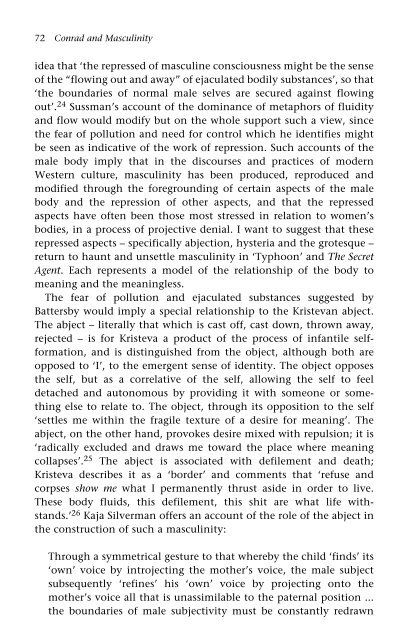Conrad and Masculinity
Conrad and Masculinity
Conrad and Masculinity
Create successful ePaper yourself
Turn your PDF publications into a flip-book with our unique Google optimized e-Paper software.
72 <strong>Conrad</strong> <strong>and</strong> <strong>Masculinity</strong><br />
idea that ‘the repressed of masculine consciousness might be the sense<br />
of the “flowing out <strong>and</strong> away” of ejaculated bodily substances’, so that<br />
‘the boundaries of normal male selves are secured against flowing<br />
out’. 24 Sussman’s account of the dominance of metaphors of fluidity<br />
<strong>and</strong> flow would modify but on the whole support such a view, since<br />
the fear of pollution <strong>and</strong> need for control which he identifies might<br />
be seen as indicative of the work of repression. Such accounts of the<br />
male body imply that in the discourses <strong>and</strong> practices of modern<br />
Western culture, masculinity has been produced, reproduced <strong>and</strong><br />
modified through the foregrounding of certain aspects of the male<br />
body <strong>and</strong> the repression of other aspects, <strong>and</strong> that the repressed<br />
aspects have often been those most stressed in relation to women’s<br />
bodies, in a process of projective denial. I want to suggest that these<br />
repressed aspects – specifically abjection, hysteria <strong>and</strong> the grotesque –<br />
return to haunt <strong>and</strong> unsettle masculinity in ‘Typhoon’ <strong>and</strong> The Secret<br />
Agent. Each represents a model of the relationship of the body to<br />
meaning <strong>and</strong> the meaningless.<br />
The fear of pollution <strong>and</strong> ejaculated substances suggested by<br />
Battersby would imply a special relationship to the Kristevan abject.<br />
The abject – literally that which is cast off, cast down, thrown away,<br />
rejected – is for Kristeva a product of the process of infantile selfformation,<br />
<strong>and</strong> is distinguished from the object, although both are<br />
opposed to ‘I’, to the emergent sense of identity. The object opposes<br />
the self, but as a correlative of the self, allowing the self to feel<br />
detached <strong>and</strong> autonomous by providing it with someone or something<br />
else to relate to. The object, through its opposition to the self<br />
‘settles me within the fragile texture of a desire for meaning’. The<br />
abject, on the other h<strong>and</strong>, provokes desire mixed with repulsion; it is<br />
‘radically excluded <strong>and</strong> draws me toward the place where meaning<br />
collapses’. 25 The abject is associated with defilement <strong>and</strong> death;<br />
Kristeva describes it as a ‘border’ <strong>and</strong> comments that ‘refuse <strong>and</strong><br />
corpses show me what I permanently thrust aside in order to live.<br />
These body fluids, this defilement, this shit are what life withst<strong>and</strong>s.’<br />
26 Kaja Silverman offers an account of the role of the abject in<br />
the construction of such a masculinity:<br />
Through a symmetrical gesture to that whereby the child ‘finds’ its<br />
‘own’ voice by introjecting the mother’s voice, the male subject<br />
subsequently ‘refines’ his ‘own’ voice by projecting onto the<br />
mother’s voice all that is unassimilable to the paternal position ...<br />
the boundaries of male subjectivity must be constantly redrawn




